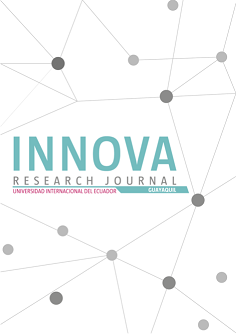M-learning, a new scenario in Higher Education in Ecuador
Main Article Content
Abstract
Technology, the Internet and telecommunications have been changing the common schemes of solving things by innovative and creative ways; With the booming mobile technology, the new models of smartphones at hand, it becomes a challenge for the teacher to use these devices as allies in the educational process. This research analyzes the application of mobile learning (M-learning) in higher education in Ecuador, specifically in the Multimedia Systems career of the Faculty of Philosophy at the University of Guayaquil where a non-experimental descriptive study was conducted, with 200 students of the I and II cycle 2017-2018 and 20 teachers to whom a structured questionnaire of 25 questions with 17 items was applied. The results showed that 96.2% of respondents use mobile devices for academic activities, 83% access digital content from their mobile devices during classes; 89% consider the application of M-learning necessary in all subjects; 78% of the teachers in attendance, think, that encourages collaborative learning among students, improving their academic performance by 90%. It was concluded that M-learning has a high level of acceptance among the university community, its use has been able to promote communication and above all create in students the mobile learning culture as a digital alternative to online education, without However, there is a need for constant training for teachers and students on the inclusion of M-learning in the curriculum, as a new learning model in higher education in Ecuador
Downloads
Article Details
COPYRIGHT NOTICE
Authors who publish in the INNOVA Research Journal keeps copyright and guarantee the journal the right to be the first publication of the work under the Creative Commons License, Attribution-Non-Commercial 4.0 International (CC BY-NC 4.0). They can be copied, used, disseminated, transmitted and publicly exhibited, provided that: a) the authorship and original source of their publication (magazine, publisher, URL and DOI of the work) is cited; b) are not used for commercial purposes; c) the existence and specifications of this license of use are mentioned.
References
Albert, M.J. (2007). La investigación educativa. Madrid: McGraw Hill.
Ávila-Fajardo, G. P., & Erazo, S. C. R. (2011). Propuesta para la medición del impacto de las TIC en la enseñanza universitaria. Education y educators,14(1), 9.
Al Hamdani, D. (2015). Exploring students’ learning style at a Gulf University: a contributing factor to effective instruction.Procedia-Social and Behavioral Sciences,176, 124-128.
Baron, J., Hirani, S., & Newman, S. (2016). Challenges in patient recruitment, implementation, and fidelityin a mobile telehealth study.Telemedicine and e-Health,22(5), 400-409.
Brazuelo, F. (2013). El teléfono móvil: actitudes, usos y posibilidades educativas. Tesis doctoral. Universidad Nacional de Educación a Distancia. Madrid, España.
Elkheir, Z., & Mutalib, A. A. (2015). Mobile Learning Applications Designing Concepts and Challenges: Survey. Research Journal of Applied Sciences, Engineering and Technology,10(4), 438-442.
Clares, J. (2006). Informática Aplicada a la Investigación Educativa. Sevilla: Digital Atres.
Colás, M. y Buendía, L. (1998). Investigación Educativa. Sevilla: Alfar.
Fried, C. B. (2008). In-class laptop use and its effects on student learning.Computers & Education,50(3), 906-914.
Fritschi, J., & Wolf, M. A. (2012). Mobile learning for teachers in North America exploring the potential of mobile technologies to support teachers and improve practive.Working paper series on mobile learning.
Hylén, J., Damme, D. V., Mulder, F., & D’Antoni, S. (2012). Open Educational Resources: Analysis of responses to the OECD country questionnaire.
Isaacs, S. (2012). Turning on mobile learning in Africa and the Middle East: Illustrative initiatives and policy implications. United Nations Educational, Scientific and Cultural Organization.
León, O. y Montero, I. (2004). Métodos de investigación en Psicología y Educación. Madrid: McGraw-Hill.
Lugo, M. T., & Schurmann, S. (2012). Turning on mobile learning in Latin America: Illustrative initiatives and policy implications.Paris, UNESCO. Retrieved on,16(09), 2016.
Parsons, D. (2014). The future of mobile learning and implications for education and training.Increasing Access,217.
Roschelle, J. (2003). Keynote paper: Unlocking the learning value of wireless mobile devices.Journal of computer assisted learning,19(3), 260-272.
Ruíz, J. (1995). El Estudio de Casos. Fundamentos y Metodología. Madrid: UNED.
Salinas, J. (2004). Innovación docente y uso de las TIC en la enseñanza universitaria.International Journal of Educational Technology in Higher Education (ETHE),1(1).
Salvat, B. G., & Quiroz, J. S. (2005). La formación del profesorado como docente en los espacios virtuales de aprendizaje.Revista iberoamericana de educación,36(1), 3.
So, H. J. (2012). Turning on mobile learning in Asia: Illustrative initiatives and policy implications. Policy focus: UNESCO working paper series on mobile learning,1, 1-32.
Traxler, J. (2005, June). Defining mobile learning. InIADIS International Conference Mobile Learning(pp. 261-266).
West, D. (2012). How mobile devices are transforming healthcare. Issues in technology innovation,18(1), 1-11.






